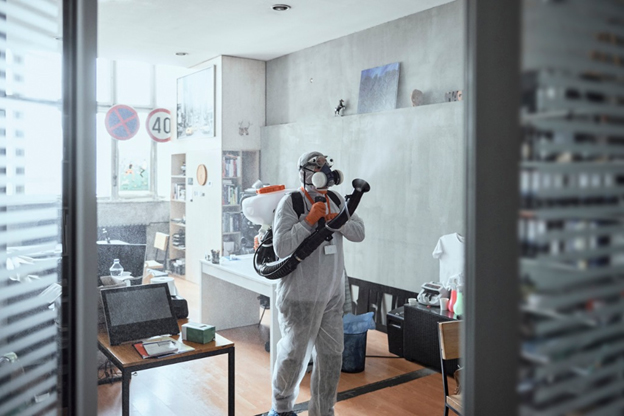As businesses across the country, start to re-open their office space, business owners are working overtime to see what precautions they need to put in place to ensure that employees and visitors are as safe as possible. The first point of reference for health and safety protocols will likely be the Center for Disease Control and Prevention (CDC). CDC’s guide is lengthy and detailed; it contains guidelines and recommendations only, but it is hoped that employers will be sufficiently concerned for the welfare of their staff to incorporate these protocols to the best of their ability.
The guide opens with a reminder to review existing guidelines and create a COVID-19 workplace health and safety plan that is shared with all staff, including maintenance and janitorial. Including everyone in the decision-making process is the best way to ensure compliance. A brief summary is included below; further details can be referenced in the guide:
Ventilation and Air Circulation
Check all ventilation systems, increasing circulation wherever possible, including bringing in outside air.
Hazard Assessment
Identify areas of the building where the risk for disease transmission is greatest; identify work and common areas where close contact is more likely.
Social Distancing
- Adjust office furniture so that desks are six feet apart
- Install shields or barriers where necessary, especially if desks cannot be sufficiently separated
- Place decals or tape on floors to delineate distances of six feet or more
- Replace communal refreshment installations such as coffee machines, water coolers and snack bins with pre-packaged, individual items
- Post signs for both workers and visitors to reinforce social distancing
- Stagger shifts and breaks
- Encourage workers to drive – alone – to work, rather than taking public transit

General Hygiene
- Frequent cleaning and disinfecting of high-touch areas
- Reminders about handwashing for at least 20 seconds
- Hand sanitizer stations
- Encouragement of the use of masks or face coverings
- No handshakes or fist bumps
- Immediate isolation of any employees who become sick while at work
- Temperature taking on arrival in the building

But What About the Environment?
Matt Richtel, writing for the New York Times, [1] raises the valid and concerning point that some of the CDC’s guidelines are a complete reversal of previous, more environmentally friendly, recommendations. For example, carpooling or using transit for one’s commute used to be encouraged; and use of pre-packaged snacks, single-use plastic water bottles, etc., was discouraged. This raises the question of priorities – how far are we prepared to go to assure good hygiene and minimize virus transmission, without completely undoing all the progress that has been made in recent years to reduce emissions and single-use plastic?
The answer, as often, might lie in finding a reasonable balance. Public transportation is likely best avoided or minimized, but not everyone has access to a private car. Active transportation – cycling or walking – can be encouraged, but will only work for those employees that live within a reasonable distance from their workplace, and are also reasonably fit and active. Whether or not there are shower/changing facilities available in the workplace will also influence workers’ decisions on this one. Reducing rush-hour congestion by staggering shifts might help make the use of public transit a little safer. For workplace refreshments, employees could be encouraged to bring coffee or water from home in their own reusable containers, along with their own eating utensils that are taken home for washing at the end of the day.
Is Remote Working a Solution?
Phasing in a return, a few workers at a time – and encouraging those who can to continue working from home – will also help solve both the commuting and the social distancing issues in office buildings. Some businesses may also find that their workers are not exactly champing at the bit to get back to the office, especially if they are currently enjoying working from home. Extending the ‘work from home’ trend may be a win-win for health and safety as well as for the planet. Perhaps surprisingly, previous experiments with teams working from home have shown that productivity actually increases, and that workers are generally happier. However, there may be some valid concerns for employers – the reliability of employees’ home internet and fears about cyber security, for example. For now, it seems many offices are physically accommodating less than half of their normal number of employees. According to a Reuters report [2] bank offices in Hong Kong, for example, are currently at anywhere between 15 percent and 50 percent of normal staffing levels.
How motivated employees may be to continue working at home will also depend greatly on both personal circumstances and personalities. Some will miss the camaraderie of colleagues and will be only too happy to return as soon as it is considered safe; others will be much happier with the relaxed home environment. Similarly, the work-from-home experience is radically different for a parent with young children at home, or a younger employee living with roommates and with limited access to personal, quiet space for phone calls and Zoom meetings, than it is for someone with a spacious home and purpose-built home office all to themselves. Forward-thinking employers will understand these differences and work in consultation with their employees to decide who would benefit more from staying at home in the medium- to long-term.
Protocols and Common Sense
Aside from the comprehensive CDC guidelines, there are many other references out there that employers can easily access. Smaller businesses, in particular, may decide to go with a combination of the key takeaways from the CDC guidelines and some basic common sense. The Canadian province of British Columbia, generally lauded across Canada for its sensible and effective approach to the pandemic, has somewhat simpler guidelines, illustrated in the handy graphic of an inverted pyramid, produced by WorkSafeBC [3]; less detail, and simple to follow:

Level 1 Elimination – Limit the number of people by phasing returning workers in slowly and encouraging continued working from home where possible, making distancing of desks and office space easier.
Level 2 Engineering controls – Barriers, if needed, for additional distancing and protection.
Level 3 Administrative controls – Rules and guidelines; reminders of hygiene measures, possibly one-way doors and walkways, etc.
Level 4 PPE – Wearing of non-medical masks if additional measures are needed
Key takeaways from different guidelines and protocols:
- Phase employees back to work slowly while continuing work-from-home arrangements where these are efficient and mutually beneficial. Stagger shifts to enable those using transit to avoid rush hour travel.
- Rearrange furniture where possible, installing screens if needed, and clearly mark walkways and waiting areas to enable social distancing.
- Make employee health and safety the paramount concern – involve all staff with decisions and ensure ongoing education and reminders on basic health and safety routines.
- Step up cleaning and disinfecting and provide adequate supplies of sanitizer, disinfectant wipes and soap.
- Encourage masks if social distancing is impossible, and/or for workers who have frequent face-to-face interactions with the public.
The virus seems likely to be something we have to live with for some time to come; establishing and reinforcing health and safety protocols in the nation’s office buildings will help employees feel more confident about returning to work while everyone adjusts to this “new normal.” But expect long lines for the elevators!
[1] Matt Richtel – New York Times – https://www.nytimes.com/2020/05/28/health/cdc-coronavirus-offices.html May 28, 2020
[2] Reuters – https://www.reuters.com/article/us-health-coronavirus-hongkong-finance/awkward-greetings-and-long-queues-as-hong-kongs-financiers-return-to-work-idUSKBN22R0E1 May 14, 2020
[3] WorkSafeBC https://www.worksafebc.com/en/about-us/covid-19-updates/covid-19-returning-safe-operation/offices

